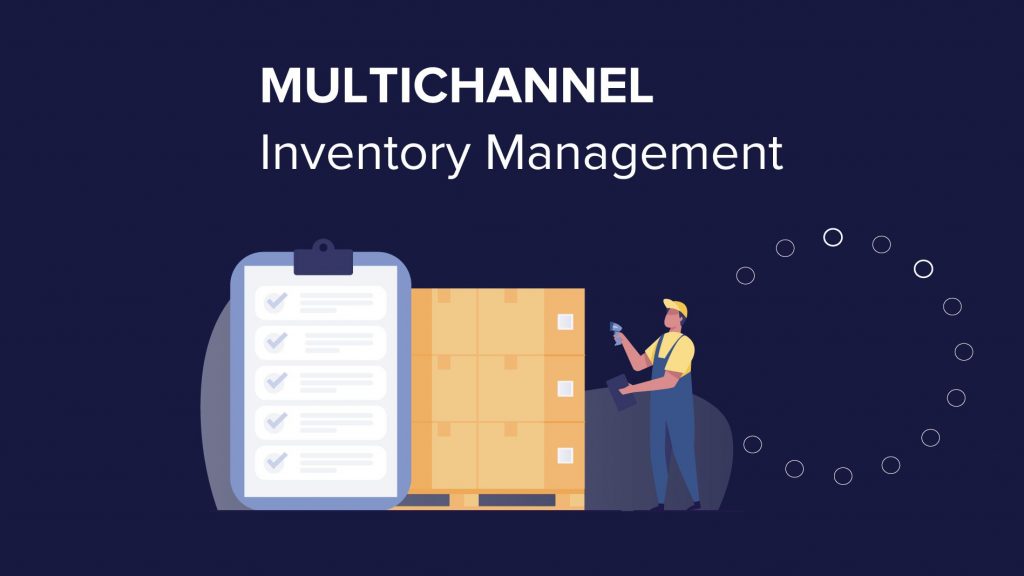Multichannel retail and distribution is no longer a novelty; instead, it has become a necessity for eCommerce businesses. There is a greater need to overcome problems linked to multichannel sales to successfully sell across multiple channels. Customers have growing demands and now expect a seamless shopping experience across all sales channels. In a growing business, unless you have the right tools and standard operating procedures (SOPs) in place to organize and secure your inventory and fulfill orders, inventory management will become a chaotic nightmare.

An agile and efficient multichannel inventory management system is an absolute necessity for effective inventory organization, maintenance, and monitoring in real-time. In this blog post, we will discuss what multichannel inventory management (MIM) is. We will also talk about the necessary tools, and external accessories that can streamline multichannel inventory management.
What is Multichannel Inventory Management?
Multichannel inventory management is the process of managing inventory and fulfilling orders across a number of sales channels. Furthermore, it involves closely monitoring the movement of inventory from storage locations and sales sources. E-commerce businesses involved in multichannel sales often sell their products either direct-to-consumer, B2B, or both on various marketplaces.
Multichannel inventory management includes managing and tracking inventory for eCommerce, marketplace, retail, as well as wholesale. It enables businesses to monitor and manage stock levels, reorders, and forecasting, with greater ease and accuracy. This enables teams to focus on multichannel business growth and new ventures instead of going over inventory records.

What are the Must-have Resources for Multichannel Inventory Management?
For businesses in search of important resources to aid them in multichannel inventory management, there is a range of useful options. These include elaborate articles, online and offline specialty courses, guides and eBooks written by domain experts, and webinars and videos.
Articles
Several eCommerce and warehousing experts offer blogs with elaborate insider information. They include tried tips and tricks for businesses to make the best of inventory management software and other processes. These blogs are easy to comprehend. The shared insights can help teams learn how to leverage the software and tools they already have in place to get better results.
Courses
A plethora of both offline and online courses are available for those seeking to learn more about inventory management and order fulfillment. These courses range from beginner level to higher proficiency. Most of them intend to impart subject matter that will show proven results and your business will experience a positive impact. Pricing options of courses vary greatly too, so it’s best to pick a course that suits both your learning needs and your budget. However, note that the capital spent on worthy courses is an investment.
Guides and eBooks
Several useful guides and eBooks are available. They can either be sourced free of cost, or downloaded, while others require a subscription or sign up. Some guides are available in both hard copy and PDF format. You can incorporate these in your teams’ training sessions and workshops.
Webinars and Videos
Several online platforms offer eCommerce webinars and videos with technical content, but the quality greatly varies so you will need to browse through the available options and check the resource for credibility.

What are the Essential Features of a Good Multichannel Inventory Management Software?
While the use of a multichannel inventory management software is essential for streamlining operations and ensuring their efficiency, choosing the right software is crucial. While shortlisting IMS, look for key features such as automated purchase orders and product listings, real-time insights, and automated shipping workflow.
Automated Purchase Orders
A multichannel inventory management system must make it easy for teams to manage and improve their relationships with key suppliers. This is achieved through proper storage of supplier information, such as information regarding minimum order levels and lead times. Furthermore, an efficient IMS tracks and manages purchase orders automatically and generates orders to replenish inventory.
Real-Time Insights
Real-time updates and insight into inventory levels are key features of a good IMS, and tracking the performance of a multichannel business is essential for streamlining processes across all channels. It must offer all key metric insights on a centralized dashboard. This way, you can get the necessary updates at a quick glance.
Improved Inventory Management
The listing of products in stock should be adjusted with automation as stock sells on each sales channel. At the same time, the amount of stock available in product listings should also be adjusted. That’s a must as inventory levels are replenished.
Better Shipping
Reducing manual tasks in shipping, picking inventory from the warehouse closest to the customers, making the picking and packing process simpler, and assigning the right shipping carrier are the tasks your IMS should conduct to improve your overall shipping experience. Nothing increases customer loyalty like fast and accurate shipping.
What are some Useful External Tools for Multichannel Inventory Management?
Choosing the right software for multichannel inventory management and enterprise resource planning is key while incorporating related hardware is optional depending on your operations. Introducing the right tools to aid your system enables an efficient product management workflow, and enables greater effectiveness and results.
Some useful options for external tools include barcode scanners, product counters, and pallet containers.
Barcode Scanners
Barcoding makes it easier to collect and integrate data, especially for businesses with multiple warehouses and constantly fluctuating levels of inventory. Moreover, barcoding lessens the risk of errors by removing error-prone and time taking tasks from inventory management.
Product Counters
Maintaining an updated and accurate count of inventory streamlines your operations. It builds a trustable database and counters are a great help with that.
Pallet Containers
If your business deals with massive volumes of products, for instance, a beverage brand with tons of carbonated soft drinks cans and bottles, physically counting every single product is near impossible. Packing together smaller products in big pallet containers with equal amounts of pre-decided units makes counting and monitoring a lot easier. Not just that, it makes storage and shipping far more streamlined as well.
Final Verdict
Businesses striving for success and scalability must treat their multichannel eCommerce strategy as their differentiating factor when competing with other businesses. Browsing and carefully selecting the necessary tools and external accessories are important to fully equip your system before you begin deploying standard protocols and ensure compliance to achieve results. Ensuring a great customer experience is key for staying in business. It’s especially important if your are in this era of rapid and far-reaching customer reviews and their impact. To ensure a seamless customer experience, a fully equipped multichannel inventory management will be the most fruitful investment decision.







